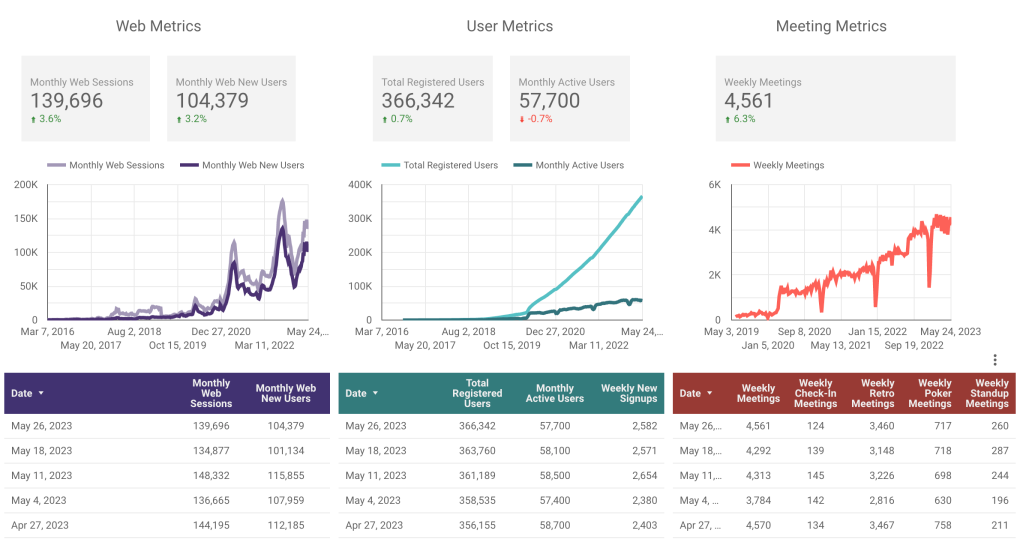#349 – Setting Designer Salaries
Friday Ship #349 | May 26th, 2023

At Parabol we value being transparent and oriented by data. This holds true for how we set compensation. The challenges we see with salaries are 1) insuring they are objective, based on an individual’s performance, role, and level, and 2) that they are competitive to what we see in the job market. As a culture, we encourage working on our policies around compensation as openly as possible. Here’s how it works for us, including a few take-aways.
Establishing levels
At Parabol we’ve developed skills matrices for each role including designer roles. This allows us to be descriptive about and test what it means to perform at a certain level. For design, we’ve developed a single matrix that allows designers to develop both a set of common design skills and specific areas of design expertise.
We have found that the primary focus of our designers is in support of the user journey of a happy customer. Therefore we have adopted ‘UX Design’ as the job family for designer roles. This is important as it forms our primary assumption for researching salaries. What tends to be a comparable position in the job market is something like ‘Senior UX Designer’ or ‘Principal Product Designer’.
In developing both our skills matrix and our salary table, we do our best to compare what we expect from a role at a certain level with ‘look-alike’ practices in the wild. We value comparing our practice and needs with what other companies have shared openly, like Buffer, from resources like Org Design for Design Orgs, or from sites like https://progression.fyi/.
Finding good data
When researching design salaries we have looked to Pave and Glassdoor.
Pave offers data-driven, real time benchmarking on compensation and equity. We’ve found their database to be reliable when comparing notes with other folks in our networks, looking at our salary histories, and looking at job postings in the wild. It gives us a good sense of what the window looks like at different percentiles for different levels. We appreciate being able to filter by the lifecycle stage of a business using parameters such as amount of capital raised, or number of employees.
We build more redundancy by comparing with community sourced data from Glassdoor. With Glassdoor, the ability to filter by years of experience and title help us calibrate what we may expect from any certain level.
Per our current compensation policy, we offer the average US salary for a role as a baseline. If an employee lives in a location where the average salary is higher than the US average, we add a supplementary amount to their base compensation. This policy allows us to be competitive for remote talent across the globe while also affording the ability to offer higher salaries in more expensive cities and hubs.
Improving through process
The best part is we’ve run this process transparently at Parabol to set baseline salary tables for designer roles and sales roles. This process allows any employee to raise questions or feedback about our approach in order to improve our policies and practice through iterations.
Specifically for designer salaries we proposed the following:
- Designer roles fall under a single job family ‘UX design’
- A transparent salary table that matches the levels of our skill matrix
- We’ll document and share the salary benchmark research
- The compensation bands allow for sub-leveling including incremental steps in compensation
- We’ll refresh this at least once a year, researching new data and updating the table
While we haven’t established normalized salary tables for ever role in the company, we use the same method and policies to research compensation as needed when hiring and promoting. While this data is fresh we can repurpose it for the same roles if others are hired or promoted within a reasonable time frame.
We believe in always making something better, realizing it’s never perfect. How do you manage compensation at your company? We’re always open to exchange field notes.
Metrics

Monthly Active Users saw a slow trickle down, but all other metrics are up.
This week we…
…continued hiring efforts for our open DevOps roles. These roles are critical to us reaching our goals, delivering our product to our customers.
…published a blog to help Scrum Masters joining a new company or a new team. For Scrum Masters on a new team, Parabol is the perfect way to get their team on track and learning positive behaviors for Scrum success.
…concluded implementation for our Activity Library. We’re looking to test where to expand both our market and our product offering. We’ve revamped how folks can find and start meeting templates in order to test what is most popular. As we button up for release, we’re going to kick off our beta experience for an initial cohort of users.
…noticed that Parabol was rated the best retro tool. Charterworks jumped in and tried a bunch of different tools. They said: “A lively, interactive interface that was easy and appealing to use by people with various technical skills put Parabol at the top of the list.”
Next week we’ll
…kick off our next Product sprints. We’re coming close to the end of a strategic cycle. We are wrapping up our efforts on Product squads, looking to measure and learn from the results, shoring up bugs and qualify improvements, and generating ideas on how to refocus for our next trimester.
